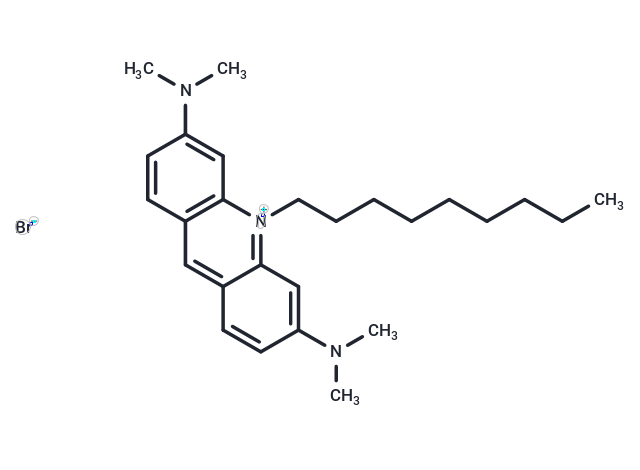Shopping Cart
Remove All Your shopping cart is currently empty
Your shopping cart is currently empty
Acridine Orange 10-Nonyl Bromide is a mitochondrial fluorescent probe that binds to cardiolipin in the inner mitochondrial membrane, dependent on the mitochondrial membrane potential, with an excitation wavelength of 490 nm and an emission wavelength of 510–525 nm.

| Pack Size | Price | USA Warehouse | Global Warehouse | Quantity |
|---|---|---|---|---|
| 5 mg | $29 | In Stock | In Stock | |
| 10 mg | $48 | In Stock | In Stock | |
| 25 mg | $113 | In Stock | In Stock | |
| 50 mg | $182 | In Stock | In Stock | |
| 100 mg | $268 | In Stock | In Stock | |
| 200 mg | $397 | - | In Stock | |
| 1 mL x 10 mM (in DMSO) | $32 | In Stock | In Stock |
| Description | Acridine Orange 10-Nonyl Bromide is a mitochondrial fluorescent probe that binds to cardiolipin in the inner mitochondrial membrane, dependent on the mitochondrial membrane potential, with an excitation wavelength of 490 nm and an emission wavelength of 510–525 nm. |
| In vitro | When Acridine Orange 10-Nonyl Bromide (AO-10NB, 45 μM) binds to cardiolipin, its fluorescence spectrum changes significantly: the excitation wavelength shifts from 496 nm to 450 nm, while the emission wavelength shifts from 525 nm to 640 nm. Studies have shown that when thin-walled vesicles containing cardiolipin (0–30 μM) are gradually added to the AO-10NB solution, the red fluorescence emission intensity at 640 nm changes regularly with the increase in the content of phospholipids or other acidic phospholipids in the liposome center. This change in fluorescence characteristics can be used as a sensitive probe to detect the distribution of phospholipids in the membrane center. [2] |
| In vivo | Acridine Orange 10-Nonyl Bromide serves as a fluorescent probe specifically for cardiolipin, exhibiting excitation (λex) at 489 nm and emission (λem) at 525 nm, enabling the quantification of cardiolipin in isolated mitochondria[1]. Interaction with cardiolipin alters its excitation and emission wavelengths from 496 and 525 nm to 450 and 640 nm, respectively. Moreover, the addition of varying levels of cardiolipin (0 to 30 μM) and other acidic phospholipids to Acridine Orange 10-Nonyl Bromide (45 μM) in thin-walled vesicles results in measurable changes in the red fluorescence emission at 640 nm, reflective of the liposome composition[2]. |
| Synonyms | Nonylacridine orange |
| Molecular Weight | 472.5 |
| Formula | C26H38BrN3 |
| Cas No. | 75168-11-5 |
| Smiles | [Br-].C1=CC(=CC=2C1=CC=3C=CC(=CC3[N+]2CCCCCCCCC)N(C)C)N(C)C |
| Relative Density. | no data available |
| Storage | keep away from moisture,keep away from direct sunlight | store at 4°C | Shipping with blue ice/Shipping at ambient temperature. | ||||||||||||||||||||||||||||||
| Solubility Information | DMSO: 25 mg/mL (52.91 mM), Sonication is recommended. | ||||||||||||||||||||||||||||||
| In Vivo Formulation | 10% DMSO+40% PEG300+5% Tween-80+45% Saline: 1.5 mg/mL (3.17 mM), Sonication is recommeded. Please add the solvents sequentially, clarifying the solution as much as possible before adding the next one. Dissolve by heating and/or sonication if necessary. Working solution is recommended to be prepared and used immediately. The formulation provided above is for reference purposes only. In vivo formulations may vary and should be modified based on specific experimental conditions. | ||||||||||||||||||||||||||||||
Solution Preparation Table | |||||||||||||||||||||||||||||||
DMSO
| |||||||||||||||||||||||||||||||
| Size | Quantity | Unit Price | Amount | Operation |
|---|

Copyright © 2015-2026 TargetMol Chemicals Inc. All Rights Reserved.